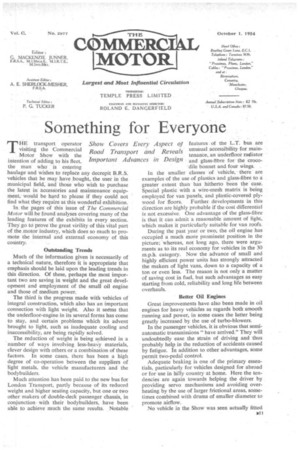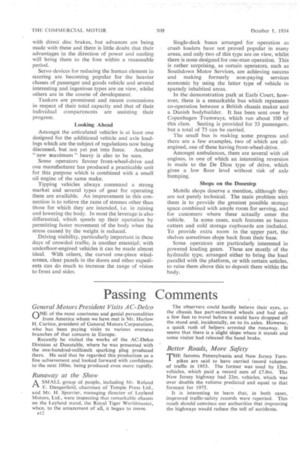Something for Everyone
Page 49

Page 50

If you've noticed an error in this article please click here to report it so we can fix it.
THE transport operator visiting the Commercial Motor Show with the intention of adding to his fleet, the man : who entering haulageand wishes to replace any decrepit B.R.S. vehicles that he may have :bought,. the user in the municipal field, and those who wish to purchase the latest in accessories and maintenanceequipment,would be hard to please if they could not find what they require at this wonderful exhibition.
In the 'pages of this issue of The Commercial Motor will.be found 'analyses covering many of the leading features of the exhibits in every section. They go to prove the great virility of this vital part of the motor industry, which does so much to promote the internal and external economy of this cotintry, Outstanding Trends Much of the information given is necessarily of a technical nature, therefore it is appropriate that emphasis should be laid upon the leading trends in this direction. Of these, perhaps the most important two are saving in weight and the great development and employment of the small oil engine and those of medium power.
The third is the progress made with vehicles of integral construction, which also has an important connection with light weight. Also it seems that the underfloor-engine in its several forms has come to stay, and certain problems which its advent brought to light, such as inadequate cooling and inaccessibility, are being rapidly solved.
The reduction of weight is being achieved in a number of ways involving less-heavy materials, clever design with others or a combination of these factors. In some cases, there has been a high degree of co-operation between the suppliers of light metals, the vehicle manufacturers and the bodybuilders.
Much attention has been paid to the new bus for London Transport, partly because of its reduced weight and higher seating capacity, but one or two other makers of double-deck passenger chassis, in conjunctionwith their bodybuilders, have been able to achieve much the same results. Notable features of the L.T. bus are unusual accessibility for maintenance, an underfloor radiator and glass-fibre for the crocodile bonnet and four wings. In the smaller classes of Vehicle,there are examples of the use of plastics and glass-fibre to a: greater -extent than has :hitherto been the case. Special plastic with a wire-mesh matrix is being employed for van panels; and plastic-covered ply wood for. floors. Further, developments in this direction are highly probable if the cost differential is not excessive. One advantage of the glass-fibre is that it can admit a reasonable amount of light, which makes it particularly suitable for van roofs.
During the past year or two; the oil engine has occupied a much more prominent position in the picture; whereas, not long ago, there were arguments as to its real economy for vehicles in the 30 m.p.h. category. Now the advance of small and highly efficient power units has strongly attracted the makers of light Vans, down to a capacity of a ton or even less. The reason is not only a matter of saving cost in fuel, -but such advantages as easy starting from cold, reliability and long life between overhauls.
Better Oil Engines Great improvements have also been made in oil engines for heavy vehicles as regards both smooth running and power, in some cases the latter being greatly increased by the use of turbo-blowers. In the passenger vehicles, it is obvious that semiautomatic transmissions" have arrived." They will undoubtedly ease the strain of driving and thus probably help in the reduction of accidents caused by fatigue. In addition to other advantages, some permit two-pedal control.
Adequate braking is one of the primary essentials, particularly for vehicles designed for abroad or for use in hilly country at home. Here the tendencies are again towards helping the driver by providing servo mechanisms and avoiding overheating by the use of larger frictional areas, sometimes combined with drums of smaller diameter to promote airflow. No vehicle in the Show was seen actually fitted with direct disc brakes, but advances are being made with these and there is little doubt that their advantages in the direction of power and cooling will bring them to the fore within a reasonable period.
Servo devices for reducing the human element in steering are becoming popular for the heavier classes of passenger and goods vehicle and several interesting and ingenious types are on view, whilst others are in the course of development.
Tankers are prominent and recent concessions in respect of their total capacity and that of their individual compartments are assisting their progress.
Looking Ahead Amongst the articulated vehicles is at least one designed for the additional vehicle and axle loadings which are the subject of regulations now being discussed, but not yet put into force. Another "new maximum" heavy is also to be seen.
Some operators favour front-wheel-drive and one manufacturer has produced a practicable unit for this purpose which is combined with a small oil engine of the same make.
Tipping vehicles always command a strong market and several types of gear for operating them are available. An improvement in this connection is to relieve the rams of stresses other than those for which they are intended, i.e. in raising and lowering the body. In most the leverage is also• differential, which speeds up their opetation by permitting faster movement of the body when the stress caused by the weight is reduced.
Driving visibility, particularly important in these days of crowded traffic, is another essential: with underfloor-engined vehicles it can be made almost ideal. With others, the curved one-piece windscreen, clear panels in the doors and other expedients can do much to increase the range of vision to front and sides. Single-deck buses arranged for operation as crush loaders have not proved popular in many areas, and only two of this type are on view, whilst there is none designed for one-man operation. This is rather surprising, as certain operators, such as Southdown Motor Services, are achieving success and making formerly non-paying services economic by using the latter type of vehicle in sparsely inhabited areas.
In the demonstration park at Earls Court, however, there is a remarkable bus which represents co-operation between a British chassis maker and a Danish bodybuilder. It has been sent over by Copenhagen Tramways, which run about 100 of this class. Seating is provided for 33 passengers, but a total of 75 can be carried.
The small bus is making some progress and there are a few examples, two of which are oilengined, one of these having front-wheel-drive.
Amongst ambulances, there are several with oil engines, in one of which an interesting reversion is made to the De Dion type of drive, which gives a low floor level without risk of axle bumping.
Shops on the Doorstep Mobile shops deserve a mention, although they are not purely technical. The main problem with them is to provide the greatest possible storage space combined with ample room for serving, and for customers where these actually enter the vehicle. In some cases, such features as bacon cutters and cold storage cupboards are included. To provide extra room in the upper part, the shelves sometimes slope back from their base.
Some operators are particularly interested in powered loading gears. These are mostly of the hydraulic type, arranged either to bring the load parallel with the platform, or with certain articles, to raise them above this to deposit them within the body.




























































































































































